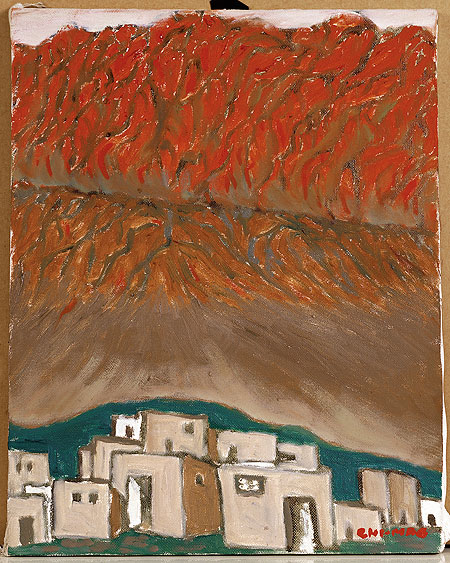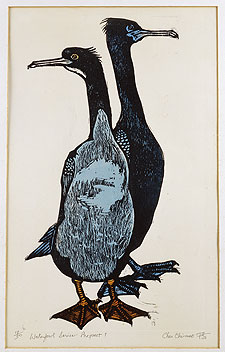| |
| |
Spring 2007
 |
|
| |
|
SHAIH Lifa 謝里法
SHORT ACQUAINTANCE;LONG MEMORIES—
A RETROSPECTIVE ON CHEN CHI-MAO
「版畫史」誕生在最後的「裝置」裡——陳其茂紀念集序*
Translated by TING Chen-wan 丁貞婉
|
Since my high school days I had often seen Chen Chi-
Mao’s woodblock prints in the newspapers and magazines.
Although I knew him in person only very recently, many of his
prints had been stored in my mind for almost fifty years. When I
was first introduced to him, his works very naturally emerged
from my memories. How true that an artist’s works best represent
the artist himself! Chen Chi-Mao, like his artworks, was
impressively ingenuous, carefree and totally at peace.
Through his prints, you could understand how he looked at
this world. Every time he hit upon something that touched his
heart, he incised it onto a wood block and then printed it out.
Through the years when he traveled around the world, he
explored many places of interest, coming up against different
cultures and customs, meeting with interesting people, and seeing
all manner of exotic flora and fauna. As if to tell the people
that his mission as a global man was to bring to notice how
splendid the world looked, he traveled extensively and tirelessly
produced print after print. This, unquestionably, was the way of
life he had chosen to pursue.
People envied the jovial and adventurous manner in which
he lived his life. How could his world be so pleasurable and
trouble free, they asked? He sketched, photographed, and then
wrote poems, essays, travelogues and made prints. He treasured |
the memories of every piece
of land he had visited. In his
woodcut prints he joyfully
and lightheartedly recreated
what he had seen—no sentimental
soliloquy nor extravagant
theories, let alone any
severe criticism. With his
dexterous application of
gouges and knives, whatever
subject matters he got hold
of were mostly pared down
to the very essentials—summarizing
his whole story in
one vignette. I imagine they
were all translated from
more complex original compositions.
Just as a professional
photographer usually |
|
| |
Prospect: No. 1 展望之一
woodcut, 53×38 cm,
1983 |
does, focusing on his subjects with medium distance shutter to
take the pictures and eliminating trivial peripherals in the dark
room, thereby to allow the central theme to stand out. The pictorial
surface of Chen’s artworks is always serene and peaceful.
He was born in an age of great turmoil and had lived through
many upheavals. Yet the world as interpreted in his artistic language
amazingly reveals happiness and joy; there is no torment
or harassment.
He always accomplished his works at the perfect stage,
admitting no room for any doubt or argument. They provide
sheer joy of visual experience. Leafing through books of his art,
I find a peace of mind like that which comes from reading fairy
tales. If you closely study his printing techniques, you will see
that he never tried to demonstrate any particular personal idiosyncrasy
either in the use of ink or printing procedures. At a
glance you know all his processes. Many artists intentionally
invent peculiar techniques to create eccentric effects. They leave
the viewers in puzzlement deciphering the grotesque techniques
rather than appreciating the works themselves. Chen Chi-Mao
simply cut and printed out his works. The black that dominates
verbally delineates his painted vocabulary.
Chen Chi-Mao also did oil paintings and water colors.
Whatever genre he did he accomplished with great ease. The
subject matters all came from what he had seen on his trips. His
artworks, for him, probably were just the records with brush and
ink to journalize experiences in his travels. There is to me, therefore,
no question as to which are good and which are bad. The
works produced by him are all good memories of his life.
I became acquainted with Chen Chi-Mao not too long ago.
Every time we met we talked about visiting each other sometime.
It was not until two years after our first encounter that I called him for his contribution to the book I was writing and
editing: History of the Development of Art in Taiwan—Taichung
Chapter. He gladly agreed to write about the part of printmaking
art development in the Taichung area. I had read his A Research
on Printmaking Art in Taiwan during the Four Decades after the
Second World War and decided that he was the most competent
person to write that section. History of the Development of Art in ....

Flaming Mountains 火焰山之一
oil on canvas 27× 38 cm, 1998
|
|
From Chen Chi-Mao yi-shu chuang-tso hui-ku-chan《陳其茂藝術創作回顧展》(Chen Chi-Mao’s 2007 Memorial Retrospective), Taichung : National Taiwan Museum of Fine Arts, 2007. The exhibition was held in Taichung City from January 27 through March 25, 2007. |
|
|


